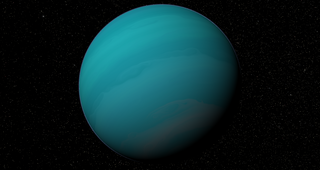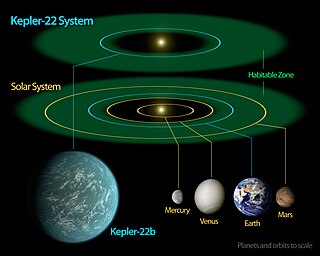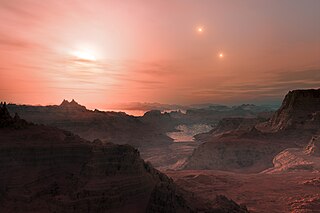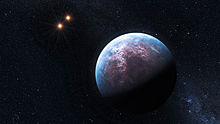
A terrestrial planet, telluric planet, solid planet, or rocky planet, is a planet that is composed primarily of silicate rocks or metals. Within the Solar System, the terrestrial planets accepted by the IAU are the inner planets closest to the Sun: Mercury, Venus, Earth and Mars. Among astronomers who use the geophysical definition of a planet, two or three planetary-mass satellites – Earth's Moon, Io, and sometimes Europa – may also be considered terrestrial planets; and so may be the rocky protoplanet-asteroids Pallas and Vesta. The terms "terrestrial planet" and "telluric planet" are derived from Latin words for Earth, as these planets are, in terms of structure, Earth-like. Terrestrial planets are generally studied by geologists, astronomers, and geophysicists.

In astronomy and astrobiology, the circumstellar habitable zone (CHZ), or simply the habitable zone, is the range of orbits around a star within which a planetary surface can support liquid water given sufficient atmospheric pressure. The bounds of the CHZ are based on Earth's position in the Solar System and the amount of radiant energy it receives from the Sun. Due to the importance of liquid water to Earth's biosphere, the nature of the CHZ and the objects within it may be instrumental in determining the scope and distribution of planets capable of supporting Earth-like extraterrestrial life and intelligence.
Gliese 581 is a red dwarf star of spectral type M3V at the center of the Gliese 581 planetary system, about 20.5 light years away from Earth in the Libra constellation. Its estimated mass is about a third of that of the Sun, and it is the 101st closest known star system to the Sun. Gliese 581 is one of the oldest, least active M dwarfs known. Its low stellar activity improves the likelihood of its planets retaining significant atmospheres, and lessens the sterilizing impact of stellar flares.

Gliese 667 is a triple-star system in the constellation Scorpius lying at a distance of about 7.2 parsecs from Earth. All three of the stars have masses smaller than the Sun. There is a 12th-magnitude star close to the other three, but it is not gravitationally bound to the system. To the naked eye, the system appears to be a single faint star of magnitude 5.89.

Gliese 876 c is an exoplanet orbiting the red dwarf Gliese 876, taking about 30 days to complete an orbit. The planet was discovered in April 2001 and is the second planet in order of increasing distance from its star.

Gliese 876 b is an exoplanet orbiting the red dwarf Gliese 876. It completes one orbit in approximately 61 days. Discovered in June 1998, Gliese 876 b was the first planet to be discovered orbiting a red dwarf.

Gliese 581c is a planet orbiting within the Gliese 581 system. It is the second planet discovered in the system and the third in order from the star. With a mass at least 5.5 times that of the Earth, it is classified as a super-Earth.

Gliese 581d was a candidate extrasolar planet orbiting within the Gliese 581 system, approximately 20.4 light-years away in the Libra constellation. It was the third planet claimed in the system and the fourth or fifth in order from the star. Multiple subsequent studies found that the planetary signal in fact originates from stellar activity, and thus the planet does not exist.

A super-Earth is a type of exoplanet with a mass higher than Earth's, but substantially below those of the Solar System's ice giants, Uranus and Neptune, which are 14.5 and 17 times Earth's, respectively. The term "super-Earth" refers only to the mass of the planet, and so does not imply anything about the surface conditions or habitability. The alternative term "gas dwarfs" may be more accurate for those at the higher end of the mass scale, although "mini-Neptunes" is a more common term.

An exoplanet is a planet located outside the Solar System. The first evidence of an exoplanet was noted as early as 1917, but was not recognized as such until 2016; no planet discovery has yet come from that evidence. What turned out to be the first detection of an exoplanet was published among a list of possible candidates in 1988, though not confirmed until 2003. The first confirmed detection came in 1992, with the discovery of terrestrial-mass planets orbiting the pulsar PSR B1257+12. The first confirmation of an exoplanet orbiting a main-sequence star was made in 1995, when a giant planet was found in a four-day orbit around the nearby star 51 Pegasi. Some exoplanets have been imaged directly by telescopes, but the vast majority have been detected through indirect methods, such as the transit method and the radial-velocity method. As of 1 May 2023, there are 5,366 confirmed exoplanets in 3,962 planetary systems, with 856 systems having more than one planet. This is a list of the most notable discoveries.

HD 85512 b is a currently-disputed exoplanet orbiting HD 85512, a K-type main-sequence star approximately 37 light-years from Earth in the constellation of Vela.

Kepler-22b is an exoplanet orbiting within the habitable zone of the Sun-like star Kepler-22. It is located about 640 light-years from Earth in the constellation of Cygnus. It was discovered by NASA's Kepler Space Telescope in December 2011 and was the first known transiting planet to orbit within the habitable zone of a Sun-like star, where liquid water could exist on the planet's surface. Kepler-22 is too dim to be seen with the naked eye.

Gliese 667 Cc is an exoplanet orbiting within the habitable zone of the red dwarf star Gliese 667 C, which is a member of the Gliese 667 triple star system, approximately 23.62 light-years away in the constellation of Scorpius. The exoplanet was found by using the radial velocity method, from radial-velocity measurements via observation of Doppler shifts in the spectrum of the planet's parent star.
Gliese 163 is a faint red dwarf star with multiple exoplanetary companions in the southern constellation of Dorado. Other stellar catalog names for it include HIP 19394 and LHS 188. It is too faint to be visible to the naked eye, having an apparent visual magnitude of 11.79 and an absolute magnitude of 10.91. This system is located at a distance of 49.4 light-years from the Sun based on parallax measurements. Judging by its space velocity components, it is most likely a thick disk star.

Gliese 832 c was a candidate exoplanet located 16.2 light-years away in the constellation of Grus, orbiting the star Gliese 832, a red dwarf. The existence of the planet was refuted in 2022, when a study found that the radial velocity signal shows characteristics of a signal originating from stellar activity, and not from a planet.
Mikko Tuomi is a Finnish astronomer from the University of Hertfordshire, most known for his contributions to the discovery of a number of exoplanets, among them the Proxima Centauri b which orbits the closest star to the Sun. Mikko Tuomi was the first to find indications of the existence of Proxima Centauri b in archival observation data. Other exoplanets to whose discovery or study Tuomi has contributed include HD 40307, HD 154857 c, Kapteyn c, Gliese 682 c, HD 154857, Gliese 221, Gliese 581 g and the planetary system orbiting Tau Ceti. He has led the development of new data analysis techniques for distinguishing observations caused by natural activity of the star and those caused by planets orbiting them.
Luyten b is a confirmed exoplanet, likely rocky, orbiting within the habitable zone of the nearby red dwarf Luyten's Star. It is one of the most Earth-like planets ever found and is the fourth-closest potentially habitable exoplanet known, at a distance of 12 light-years. Only Proxima Centauri b, Ross 128 b, and Gliese 1061 d are closer. Discovered alongside Gliese 273c in June 2017, Luyten b is a Super-Earth of around 2.89 times the mass of Earth and receives only 6% more starlight than Earth, making it one of the best candidates for habitability. In October 2017 and 2018, the nonprofit organization METI sent a message containing dozens of short musical compositions and a scientific "tutorial" towards the planet in hopes of contacting any potential extraterrestrial civilizations.
Kepler-737b is a super-Earth exoplanet 669 light years away. There is a chance it could be on the inner edge of the habitable zone.















